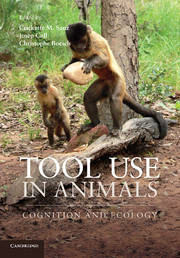Book contents
- Frontmatter
- Contents
- List of contributors
- Part I Cognition of tool use
- 1 Three ingredients for becoming a creative tool user
- 2 Ecology and cognition of tool use in chimpanzees
- 3 Chimpanzees plan their tool use
- Part II Comparative cognition
- Part III Ecology and culture
- Part IV Archaeological perspectives
- Index
- References
1 - Three ingredients for becoming a creative tool user
from Part I - Cognition of tool use
Published online by Cambridge University Press: 05 March 2013
- Frontmatter
- Contents
- List of contributors
- Part I Cognition of tool use
- 1 Three ingredients for becoming a creative tool user
- 2 Ecology and cognition of tool use in chimpanzees
- 3 Chimpanzees plan their tool use
- Part II Comparative cognition
- Part III Ecology and culture
- Part IV Archaeological perspectives
- Index
- References
Summary
The bird approaches the transparent vertically oriented tube and looks down its opening with apparent interest. Then it looks at the tube from the side and walks around the tube to look down into the opening with one scrutinizing eye once more. There is a worm located at the bottom of the tube, beyond the bird’s reach. After a few seconds, the bird steps away from the tube, picks up a stick with its beak and inserts it down the tube’s opening. Once inside, it grabs the tool again and applies downward pressure on it so that the tool dislodges the platform that is keeping the worm inside the bottom of the tube. The worm drops free from the bottom of the tube to be picked up by the bird, which quickly flies away.
Observations like this pose a double challenge to researchers in the field of comparative cognition. The first challenge is to explain why some species can come up with innovative solutions while others facing the same situation do not do so. For instance, pigeons presented with the same task as crows and left to their own devices may be incapable of producing the same solution, even after hours of exposure to the same problem. One possible explanation for this outcome is that this crow species, unlike the pigeons, may have a strong predisposition to using tools since this has offered it an adaptive advantage. In fact, the crow is in all likelihood a New Caledonian crow (Corvus moneduloides), well known for their propensity and dexterity at making and using tools to extract embedded food from substrates. The fascinating thing is that the above description is not about a New Caledonian crow, but a distantly related cousin, the rook (Corvus frugilegus). Rooks, unlike New Caledonian crows, do not usually use tools in this way, but they can do so in the laboratory, as Bird and Emery (2009) discovered. This revelation poses a second challenge to comparative researchers: How are rooks solving this problem? What cognitive mechanisms are responsible for the observed behavior and what experiences are necessary for this clever solution to emerge? Since all species are endowed with associative learning mechanisms, a key question to be explained is where interspecific differences come from. Nowhere is this challenge so acute as in the area of tool use in animals.
- Type
- Chapter
- Information
- Tool Use in AnimalsCognition and Ecology, pp. 3 - 20Publisher: Cambridge University PressPrint publication year: 2013
References
- 41
- Cited by



